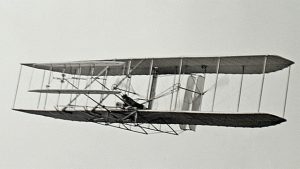As railroads expanded in West Virginia at the turn of the 20th century, remote tracts of virgin timber became accessible. The development of a spur of the Chesapeake and Ohio Railroad that ran up the Greenbrier River from Ronceverte led to a saw mill being built by the West Virginia Spruce Lumber Company in 1902 and the establishment of Cass in Pocahontas County. Grown only at high elevations, West Virginia’s Red Spruce trees were sought after for pulpwood, boat manufacturing, and musical instrument making. On March 5, 1904, the Wright Cycling Company of Dayton, Ohio wrote the West Virginia Spruce Lumber Company. Signed by Wilbur Wright, the letter described the Wright Brothers’ search for the “finest possible spruce, free of knots with grains “free from twist.” Wright further wrote, “We found it impossible to obtain this lumber in our local yards.” A check stub at the Wright State University Library’s archives reveal that the Wright Brothers purchased $45 worth of lumber from the West Virginia Spruce Lumber Company. Red Spruce and Ash were used in the construction of the Wright Brothers’ airplanes. Presumably, West Virginia played a part in the history of aviation.
West Virginia’s Red Spruce forests were an important part of the Appalachian ecosystem. Over harvested, the forests were subjected to erosion and forest fires and have all but disappeared. Other species of trees grew where the Red Spruce once did. Efforts are underway by conservation organizations, including the Nature Conservancy, to plant Red Spruce seedlings and restore West Virginia’s Red Spruce forests.
Photo of the Wright Brothers’ 1904 Flyer II from Wikimedia.
Sources: The Columbus Dispatch, Tumult On The Mountains by Roy B. Clarkson, Nature Conservancy.




